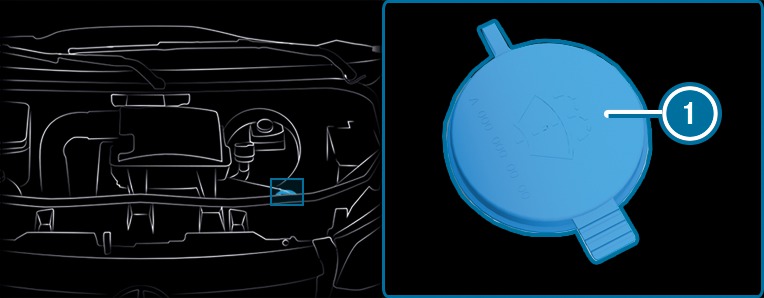Damaged tyres can cause tyre pressure loss.
Check the wheels and tyres of your vehicle for damage regularly, i.e. at least every two weeks, as well as after driving off-road or on rough roads. Damaged wheels can lead to a loss of tyre pressure.
cuts in the tyres
punctures in the tyres
tears in the tyres
bulges on tyres
deformation or severe corrosion on wheels
Insufficient tyre tread will result in reduced tyre grip.
The risk of aquaplaning is increased on wet roads, especially when the speed of the vehicle is not adapted to suit the conditions.
Summer tyres: 3 mm
M+S tyres: 4 mm
check the tyre pressure More
check the valve caps
Valves must be protected from moisture and dirt with valve caps specifically approved by Mercedes-Benz for your vehicle.
visually inspect the tread depth and the tyre tread across the whole tyre width
The minimum tread depth for summer tyres is 3 mm and on winter tyres 4 mm.
Vehicles with rear-wheel drive: if you have fitted snow chains to the front wheels, they may drag against the vehicle body or chassis components.
Vehicles with front-wheel drive: if you have fitted snow chains to the rear wheels, they may drag against the vehicle body or chassis components.
Commercially available snow chains can come loose and damage chassis components or brake hoses.
For safety reasons, Mercedes-Benz recommends that you only use snow chains that have been checked and approved. You can obtain information about snow chains from any qualified specialist workshop.
If you drive too fast with snow chains, they can break, injure other persons, and damage the vehicle.
If snow chains are fitted to steel wheels, the wheel trims can be damaged.
Snow chains are only permissible for certain wheel/tyre combinations. You can obtain information on this at a qualified specialist workshop.
For safety reasons, only use snow chains that have been specifically approved for your vehicle by Mercedes-Benz , or snow chains with the same quality standard.
The snow chains must be retightened after driving approximately 1 km. This is the only way to ensure the snow chains are optimally seated with clearance to adjacent components.
Vehicles with all-wheel drive: fit snow chains to all wheels. On vehicles with twin tyres, fit the snow chains to the outer wheels. Observe the manufacturer's installation instructions.
Use snow chains only when the road surface is completely snow-covered. Remove the snow chains as soon as possible when you come to a road that is not snow-covered.
Local regulations may restrict the use of snow chains. Observe the applicable regulations before fitting snow chains.
Activate all-wheel drive before driving off with snow chains MoreMore.
If snow chains are fitted, the maximum permissible speed is 50 km/h.
Vehicles with Parking Assist: do not use Parking Assist PARKTRONIC if snow chains are fitted.
You can permanently limit the maximum design speed for driving with winter tyres More.
You can deactivate ESP® to pull away More. This allows the wheels to spin, achieving an increased driving force.
Observe the notes on operating fluids More.
Windscreen washer concentrate is highly flammable. It could ignite if it comes into contact with hot engine component parts or the exhaust system.
Unsuitable windscreen washer fluids may damage the plastic surface of the exterior lighting.
Do not use distilled or de-ionised water. Otherwise, the fill level sensor may give a false reading.
Certain components in the engine compartment can be very hot, e.g. the engine, the radiator and parts of the exhaust system.
bonnet
engine oil filler opening cap
washer fluid reservoir cap
coolant expansion reservoir cap
If you open the engine bonnet when the engine has overheated or during a fire in the engine compartment, you could come into contact with hot gases or other escaping operating fluids.
Windscreen washer concentrate is highly flammable. It could ignite if it comes into contact with hot engine component parts or the exhaust system.

 upwards by the tab.
upwards by the tab.  onto the filler opening until it audibly engages.
onto the filler opening until it audibly engages. If the windscreen wipers begin to move while you are changing the wiper blades, you can be trapped by the wiper arm.
If the windscreen wipers start moving when the bonnet is open, you could be trapped by the wiper linkage.
If the wiper blades are worn out, they will no longer wipe the windscreen properly. Replace the wiper blades twice a year, preferably in spring and autumn.

 away from the windscreen.
away from the windscreen.  and turn the wiper blade away from wiper arm
and turn the wiper blade away from wiper arm  in the direction of the arrow as far as it will go.
in the direction of the arrow as far as it will go.  upwards in the direction of the arrow until it engages.
upwards in the direction of the arrow until it engages.  from the wiper arm.
from the wiper arm.  in the holder on wiper arm
in the holder on wiper arm  .
. Driver's side: long wiper blade
Front passenger side: short wiper blade
 downwards until it engages.
downwards until it engages.  back onto the windscreen.
back onto the windscreen. If the tailpipe is blocked or sufficient ventilation is not possible, poisonous exhaust gases such as carbon monoxide may enter the vehicle. This is the case in enclosed spaces or if the vehicle gets stuck in snow, for example.
Flammable materials such as leaves, grass or twigs may ignite.
Operating the stationary heater or stationary ventilation drains the battery.
The fuel tank is filled above the reserve level.
The vehicle is switched on.
Ensure that A, B and C each correspond to a programmed departure time.
The programmed time will remain set only until the next time the vehicle is started.
The required programmed time – A, B or C – will appear only if the box to activate the departure time is ticked.


